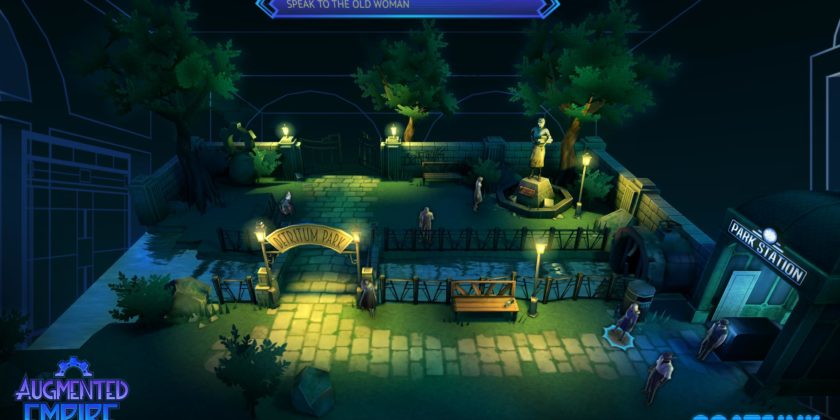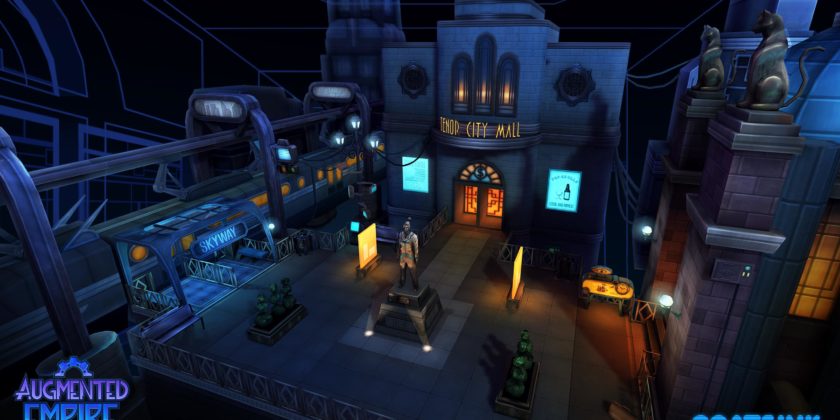Creating a VR gaming revolution: Coatsink’s augmented empire
“ In 2013, the first modern VR developer kit was created by Oculus. Five years on and we’re on the verge of fully wireless, inside-out tracking VR technology where people are able to freely move and interact in a virtual space, untethered from a computer. To extrapolate that speed of innovation, in five to 10 years we could see immersive tech that is able to truly suspend disbelief with zero physical restrictions and greater visual fidelity for experiences that not only transcend reality but enhance it.”
— Eddie Beardsmore, COO Coatsink
Driven by a passion for creating unique and innovative video game experiences, Coatsink was founded in 2009 by Tom Beardsmore and Paul Crabb. Achieving fast growth in a short time, over the last year the company has grown from 30 to over 50 employees and to date has developed for PC, PS4, PS Vita, Nintendo Switch, Oculus Rift, Gear VR and Microsoft mixed reality platforms.
In July 2017 the company wowed the VR gaming community when it launched the pioneering Samsung Gear VR game Augmented Empire. Its praise was lavish.
“Augmented Empire‘s storytelling is brilliant from start to finish” GameSpew
“If you’re looking for a polished, narrative-driven gem of a VR game, look no further” Gameskinny
UploadVR described it as “a rare treat for a mobile VR game in that it offers a ton of content, a compelling narrative, and cleverly designed encounters that really challenge you while maintaining a fun and well-designed gameplay loop”.
To date this critically acclaimed mobile VR role-playing game (RPG) has come to be widely regarded as one of the deepest and most accomplished experiences on the platform.
For the uninitiated, Samsung Gear VR is the most popular head-mounted display (HMD) on the market, not including Google Cardboard, and Coatsink is seen as one of the platform’s most ardent supporters. Pre Augmented Empire, the team at Coatsink had produced other popular games for the headset, including Esper, Esper 2 and A Night Sky.
What is Augmented Empire?
It’s described by Coatsink as “a story-driven tactical RPG set on the island of New Savannah, an isolated neo-noir city divided into three tiers by the Citizen Grade System”. High value citizens live in luxury at the summit, outliers and criminals exist in squalor at the island’s depths. The player uses look-and-click controls to instruct their team of six augmented misfits in a world rendered as an “augmented reality” diorama, interacting with the office around them to investigate new developments, make calls, and develop the skills of their team.
“Blending stunning visuals and turn-based action, Augmented Empire brings a cyberpunk tale of disparity and hope to VR,” says Coatsink marketing manager Kane Forrester. Features include Gamepad and Gear VR controller support, 10+ hours of gameplay across 26 missions, combining exploration and turn-based action and a cyberpunk story featuring six upgradable characters and 60 environments.
One of the key differentiators for this game is the soundscape, with scripts voiced by leading actors including Kate Mulgrew (Star Trek Voyager), Nick Frost (Shaun of the Dead), Doug Cockle (The Witcher series), Garrick Hagon (Star Wars: Episode IV – A New Hope). The cast discuss their experience in an interesting behind-the-scenes video that delves into the mechanics of making the game.
 The game was launched exclusively on Samsung Gear VR, powered and funded by Oculus. Coatsink’s Tom Beardsmore says: “With a strong focus on story and deep but accessible gameplay, we wanted to give Gear VR gamers an extraordinary experience. We’re thrilled with the calibre of talent involved in Augmented Empire”. Narrative Designer Jon Davies adds, “The whole team’s extremely proud of what we achieved with Augmented Empire and we’re thrilled with the passion and talent of the actors involved”.
The game was launched exclusively on Samsung Gear VR, powered and funded by Oculus. Coatsink’s Tom Beardsmore says: “With a strong focus on story and deep but accessible gameplay, we wanted to give Gear VR gamers an extraordinary experience. We’re thrilled with the calibre of talent involved in Augmented Empire”. Narrative Designer Jon Davies adds, “The whole team’s extremely proud of what we achieved with Augmented Empire and we’re thrilled with the passion and talent of the actors involved”.
The team behind the project reveal that the main objective of the game was to create an RPG for the Gear VR platform with accessible turn-based combat and a truly immersive story, adding: “We aimed to create an emotional link between the player and the story which connected to a changing environment as a consequence of your actions in augmented reality to make each players experience feel personal.” They wanted to create a sense of a space changing around the player, (the penthouse in which the player sits for the game’s duration for example) as a consequence of their actions in augmented reality.
What technology did they use?
Augmented Empire was built in Unity for Samsung Gear VR. As the team explain, Unity’s flexibility allowed for quick prototyping and creation of different experiences – Augmented Empire mixes first-person story sections and third-person combat and exploration. Plus, its comprehensive platform integration allowed them to make gameplay changes, then have the game testable on a VR device in minutes.
Over the years, Coatsink has also developed a number of editor-specific tools to help them manage cut-scenes and lighting, vital in creating the story and neo-noir atmosphere for which Augmented Empire was lauded.
Multi-scene editing allowed different areas to be worked on by multiple team-members at once, which was essential given the team size at the height of development. With over 40 developers working on the game simultaneously, multi-scene editing allowed the artists to continue to make changes and optimise, while the designers and programmers could focus on gameplay and logic.
Finally, the native C# language is easy to use, which allowed basic scripts to be written, tested and edited rapidly by designers without relying on constant code support.
As well as Unity, Coatsink also uses Maya, Max and Photoshop, which are the industry standards when it comes to art and animation, plus Visual Studio to code and FMOD to design and manage the audio.
What was the time-frame for the project?
The playable demo for the game was created over a period of three months in order to secure funding for the project from Oculus Studios. Full development began in July 2016 and lasted for 11 months, with the game launching in July 2017.
What challenges did the team encounter?
Finding and hiring team members with the right skills and attitude is a constant challenge for the VR development community, say the team. Kane Forrester adds: “Games development requires relatively niche skills to begin with, which become more niche when attempting to develop game experiences for mobile VR.”
Kane explains that with a development timeline of less than 12 months, bringing an experience of Augmented Empire’s quality to a newly established technology and platform was a big challenge.
“In order to achieve this, the experience utilised a diorama style, third person play perspective – an experience which works well in virtual reality. It also enabled the project to be realistically scoped from a code, art, animation and testing perspective.”
How was the game received in the market?
With wild enthusiasm from the critics as we’ve already seen, with a slew of 5/5 and 10/10 reviews. And, very importantly, gamers liked it too with reviews on the Oculus website calling it “amazing – by far the best game I’ve played on the GearVR. The graphics, gameplay and story are wonderful” and “Absolutely brilliant – hope there’s going to be a part 2”.
What effect has it has on the sector?
Augmented Empire is considered a flagship game experience for Gear VR. It was the first tactical RPG created exclusively for VR and Coatsink cite it as an example to the sector of what can be achieved in this space.
The turn-based tactics (TBT) genre is typically more associated with PC and console gaming, with its emphasis on strategy delivering a more deliberate, cerebral experience that would, at initial glance, seem contrary to the thrill and immediacy of VR. However, as the team at Coatsink explain, Augmented Empire excels by making this contradiction its central premise.
“In a neo-noir city, the player controls a cybercriminal mastermind from the comfort of their armchair, directing characters in a holographic diorama rendered in front of them.
Combining high production values, an all-star cast, and a story praised for its rich characters and detailed world, Augmented Empire is a VR experience like no other, proving even the most unlikely genres can shine in virtual reality.”
With games now beginning to see mainstream adoption in the augmented reality (Pokemon Go) and mixed reality spaces, and as the hardware for VR/AR/MR matures and becomes even more affordable over the next few years, Coatsink believe that VR will begin to see mainstream adoption globally and become commonplace across all sectors of industry. They explain that they and other hardware and software developers are only just starting to scratch the surface with what is possible.

What’s next for Coatsink?
Kane Forrester confirms that they are currently working on three unannounced VR projects, one of which is working in conjunction with indie game developer Fierce Kaiju to develop an inspirational experience that will use the very latest in VR technology.
“We’re thrilled to be collaborating with such a talented team and the creators one of our office game night favourites, Viral Quarantine. We can’t wait to show VR fans what we have planned.”
— Eddie Beardsmore, Coatsink